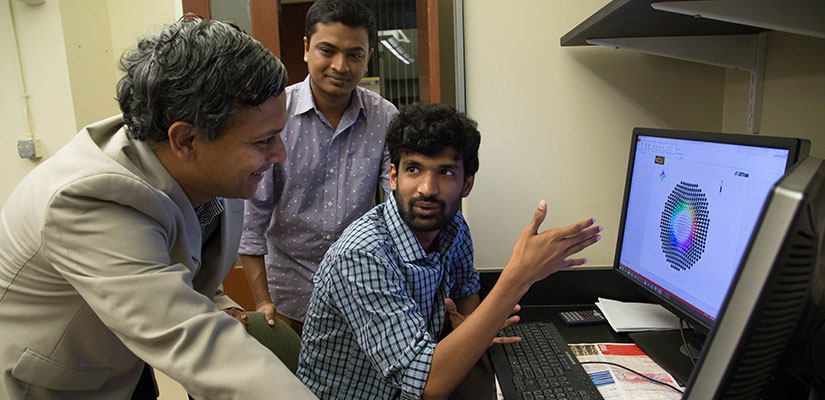The era of cloud computing and big data has put a premium on storing more information in ever-smaller packets. A research team in the VCU School of Engineering is meeting this need with a magnetic data-storage technology that dramatically reduces energy consumption. Their work has attracted attention from the scientific community, and its commercial applications are garnering investor support.
“The promise of this invention is that it only involves a minor modification to existing memory technology but can reduce the energy consumed by many orders of magnitude,” said Jayasimha Atulasimha, Ph.D., Qimonda professor in VCU’s Department of Mechanical and Nuclear Engineering.
Atulasimha and Ph.D. candidates Dhritiman Bhattacharya and Md Mamun Al-Rashid are developing a more efficient approach to the way that magnets store and transmit information. Magnets are widely used for this purpose because the “up” or “down” polarity — the magnetic state — of individual magnetic particles can be “flipped” to encode and store data permanently. Magnetic patterns are used on credit cards and hotel room keys, and nanoscale magnetic elements are used in hard drives of many computers. Using magnetic random access memory elements in computer processors, laptops and other electronic devices offers two key advantages: information is non-volatile, and it can be stored without consuming power.
Electric current or magnetic fields are commonly used to flip magnetic particle polarities and “write” information into a magnet. One of the team’s innovations is in using electric fields to achieve this by employing the skyrmion as an intermediate state. A skyrmion is the magnetic state that a particle enters while its polarity is rotating from “down” to “up” or vice versa. Last summer, the group showed that electric voltage alone, plus manipulation of the skyrmion state, can flip the magnetic state very efficiently. They published this finding in Scientific Reports, the online journal from the publishers of the journal Nature.
With funding from VCU’s Quest Commercialization Fund in spring 2017 and the Virginia Microelectronics Consortium (VMEC), they are now studying the feasibility of their energy-saving process at room temperature. This is important because nanomagnet polarities are constantly vibrating, and heat increases those vibrations. “The higher the temperature, the more the nanomagnets’ magnetic orientation is knocked around, and this can cause errors even at room temperature,” said Bhattacharya.
The skyrmion-generating effect of an additional heavy metal layer, combined with voltage application, “may provide an extremely energy-efficient and at the same time robust pathway to switch the magnetic state of memory devices,” Al-Rashid said.
They have applied for a full patent and their technology is currently protected under an international Patent Cooperation Treaty (PCT) filing. They will continue their simulation work through the summer. “Scientifically, we have a better claim by showing that the process is robust in the presence of thermal noise. Furthermore, the intermediate skyrmion state offers a robust pathway for switching the magnetic state,” Atulasimha said. “We’re an important step closer to showing that feasibility.”
